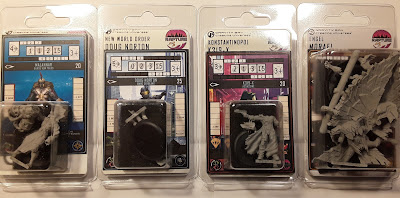(continued from the butterfly end of my recent workbench update)
Recap: I recently ran across a new Sci Fi skirmish wargame from some enthusiasts from Germany, called Rapture by Gravity Bay (btw, the game name is great, but not suitable at all as a hashtag / search term... I'll go for #RaptureTheGame instead). The artwork is gorgeous, the story (near future post-pandemic SciFi) fascinating and, although I don't play much, still motivating for me: the rules look eminently playable, fast paced and modern (more on that below).
A "print and play" preview of the game with rulebook and printable counters and proxies for the minis is available free of charge here.
After a 12 month+ grassroot campaign where the game was presented at big shows and in various gaming clubs (look for "Gravity Bay Rapture" on Youtube for examples), the game is about to go to Kickstarter (placeholder here) for funding of a first normal production run.
Until then, a handful of minis is already available in the Gravity Bay online shop today, so I couldn't resist ordering a few to try them out. Here's a first report on what I got.
Turnaround time from order to delivery was so-so, but I wasn't in a hurry. And I even got a friendly note handwritten on the back of the invoice, a very nice gesture.
Although I spend 98% of my non-historical tabletop time with building and painting and very rarely actually play the games, I had read through the preview rule book and quickly saw many things I really like. Maybe this game will even by playable in real life. Things I like about the game include:
Things I don't like after first read through: 1. Additional purchase needed to play: one of the really cool game features is that unit stats change as the game progresses, e.g. as units use life points and/or morale. But these changes need to be marked on the unit cards - to do that without damaging them you need transparent card sleeves and a wipe-off felt tip pen. I know where to get the sleeves (just have to hit the right size) but not the pen, and would like to get both packaged with the game instead of having to chase them separately. 2. No premeasurements of movement and firing distances - I don't like this in other tabletops, either (maybe another reason why I used to enjoy Demonworld so much, I guess I'm a board gamer at heart). It rewards a weird talent (estimating distances between an inch and a foot), and encourages gamy behavior like taking pre-measuring terrain pieces (for exaple, I have 25x50 cm terrain plates, giving me an unfair advantage over opponents who don't know this), or taking unimportant pot shots to get a "free" measurement. However, I'll be happy to accept the pot shots (not the pre-game measuring, though) as a feature, not a bug, after trying it out in reality.  |
| The boosters with the first minis. Each contains pieces for one mini, a round slotted base, a unit card with stats and a backdrop with a photo, product information and the legal blurb. F.l.t.r.: one mini each for the factions of Atlantis, New World Order (humans), an individual mercenary (crossover model from another game, event mini only) and an Angel. |
After unpacking, the first impressions of the minis are very good. They look really nice, have fantastic, fine detail (e.g. very vivid, expressive faces), dynamic-but-not-silly poses, good detail, and big diversity in size/impression/character.
And best of all: correct proportions (!) - wow. That's what drove me away from many classical tabletop minis and back to the good old German flats, I just don't like the chubby / chibi proportions of the traditional metal tabletop minis (historical, fantasy or Sci-Fi) and even many of their plastic and resin successors, where forearms are as thick as correctly proportioned thighs, fists as large as heads and gun barrels as thick as arms. But these minis have really thin, correctly proportioned gun barrels, fingers, even noses. Nice.
 |
| Unpacking the first minis: unit cards with picture and stats on the front (and special rules summaries on the back), and the 2-3 part minis for Atlantis and NWO. |
Assembly of the Angel was interesting, because many pieces and links required careful cleaning. But overall it went nicely and at first glance normal modelling super glue seems to create very hard and stable bonds quickly.
 |
| The assembled minis, waiting to be basecoated. |



Keine Kommentare:
Kommentar veröffentlichen